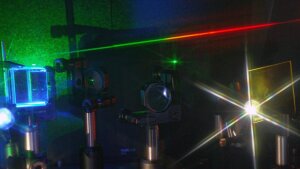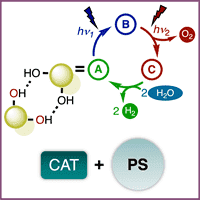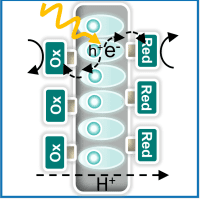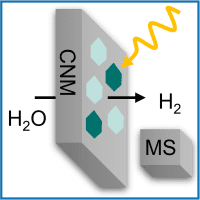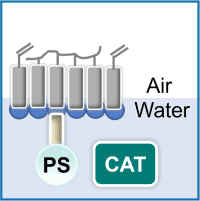
Research Area A - Molecular Components
-
A1 – Strategies for Molecular Repair and Self-regulation in Light-driven Catalysis for Hydrogen Evolution (Benjamin Dietzek-Ivanšić, Ksenija Glusac, Sven Rau)
Strategies for Molecular Repair and Self-regulation in Light-driven Catalysis for Hydrogen Evolution
Graphic: CataLightA1 is dedicated to mechanistic studies on molecular dyads and triads for light-driven catalysis. The project will investigate how concepts for active repair of molecular dyads can be controlled by molecular design and how matrix integration can be utilized to prevent major degradation paths. Novel non-noble metal PS-CAT dyads will be explored, and the transfer of concepts for degradation prevention and molecular repair, from noble-metal model systems to non-noble metal dyads and triads will be studied.
-
A3 – Metal-free Photosensitizers and their Application as Molecular Chromophore-Catalyst Systems (Kalina Peneva, Sven Rau)
Metal-free Photosensitizers and Their Application as Molecular Chromophore-Catalyst Systems
Graphic: CataLightA3 examines the synthesis, functionalization, and photophysical tuning of perylene, BODIPY, and naphthalene dye photosensitizers, their integration into PS-CAT dyads and soft matter matrices using covalent and supra-molecular approaches. Automated screening and optimization of light-driven catalysis experiments will be run to enable fast analysis of photosensitizer performance in model light-driven catalytic reactions. Performing photophysical and catalytic analyses of selected PS in solution and when integrated in matrices.
-
A4 – Covalently Linked Photosensitizer-Catalyst Dyads for One-step Materials Integration (Stephan Kupfer, Sven Rau, Carsten Streb)
Covalently Linked Photosensitizer-Catalyst Dyads for One-step Materials Integration
Graphic: CataLightA4 explores covalently linked PS-CAT dyads and triads based on metal complex or organic PS as well as polyoxometalate or metal complex catalysts for light-driven reduction and oxidation reactions. Theoretical modeling of the electronic and photophysical properties will be performed and correlated to the experimental properties of the systems. Peripheral functionalization will be used to enable covalent and supramolecular matrix integration with a focus on the hydrogen evolution reaction, NAD+-reduction, alcohol and water oxidation.
-
A5 – Experimental and Theoretical Studies on Molecular Molybdenum Sulfide Hydrogen Evolution Reaction Catalysts (Timo Jacob, Carsten Streb)
Experimental and Theoretical Studies on Molecular Molybdenum Sulfide Hydrogen Evolution Reaction Catalysts
Graphic: CataLightA5 will develop a new generation of thiomolybdate HER catalysts. In a joint experimental-theoretical approach we will investigate the structural and chemical tuning and modify model clusters by metal-functionalization and ligand tuning. Matrix embedding using electrostatic or covalent concepts will be explored in collaboration with B-projects. Operando studies of homogeneous and heterogenized systems will be carried out with C- and Z-projects.
-
A6 – Organic Molecules and Materials to Promote Noble Metal-free and Coupled Light-driven Catalysis (Birgit Esser)
Organic molecules and materials to promote noble metal-free and coupled light-driven catalysis
Graphic: CataLightA6 explores organic molecular compounds for light-driven catalysis. We will develop (1) organic photosensitizers making use of the thermally activated delayed fluorescence (TADF) concept and use them in light-driven reactions to replace rare noble metal-based photosensitizers. We will develop (2) redox-active organic compounds that allow coupling oxidative and reductive reactions, and their incorporation in soft matter matrices. They will be used in (reductive) hydrogen evolution reactions as well as in coupled reaction schemes of oxidation and reduction.
-
A7 — Two-photon water splitting as an Enabling Approach for Coupled Photocatalysis (Jacob Schneidewind)
Two-photon water splitting as an Enabling Approach for Coupled Photocatalysis
Graphic: CataLightA7 aims to deepen our understanding of two-photon water splitting und to generalize its use for coupled photocatalysis. Two-photon water splitting is a unique mechanistic approach which allows for overall water splitting with one type of metal complex via the consecutive absorption of two photons with different wavelengths by two reaction intermediates. The project aims to build a toolkit for the general application of this approach, to transfer the reactivity from ruthenium to non-noble metal complexes and to explore synergies with soft matter matrices that provide preorganization and charge transfer capabilities.
-
A8 — Integration of Nobel metal-free Catalysts in Soft Matter Matrixes to enable light-driven catalysis (Birgit Weber)
Integration of Nobel metal-free Catalysts in Soft Matter Matrixes to enable light-driven catalysis
Graphic: CataLightA8 provides a large pool of 3d metal complexes (M = Fe, Co, Ni, Cu) that will be screened in a high-throughput approach to identify active combinations with photosensitizers for the photocatalytic hydrogen evolution reaction. Furthermore, catalytically active complexes for water oxidation already investigated in the Weber group are functionalized with alkyl chains to enable integration into lipid bilayers or for integration into hydrogels.
Research Area B - Soft Matter Matrices
-
B2 – Integration of Photoredox-active Complexes in Redox-active Polymers for Light-induced Charging and Discharging by Additional Integrated Molecular Catalysts (Sven Rau, Ulrich S. Schubert)
Integration of Photoredox-active Complexes in Redox-active Polymers for Light-induced Charging and Discharging by Additional Integrated Molecular Catalysts
Graphic: CataLightB2 will explore light-induced electron-transfer between PS/PS-CAT based on noble metal-free building blocks and redox-active polymers. Effects of the polymer structure and morphology on the efficiency of the overall redox cascade will be explored. Enabling the development of a polymeric Z-scheme, light-driven reductive charging of redox polymers will be coupled to alcohol oxidation using PS-CAT dyads and robust conducting polymers will be oxidized to fuel the light driven hydrogen evolution catalysis with PS-CAT dyads.
-
B3 – “POMbranes” – Incorporation of Catalytically Active Polyoxometalates into Integral Asymmetric Block Copolymer Membranes (Kerstin Leopold, Felix Schacher, Carsten Streb)
B3 – “POMbranes” – Incorporation of Catalytically Active Polyoxometalates into Integral Asymmetric Block Copolymer Membranes
Graphic: CataLightB3 explores how molecular light-driven reactivity changes upon matrix integration. The project will study the stability of block copolymer membranes as matrices and assess important reaction parameters under HER and WOC operation conditions. Thereby exploring effects of electrostatic and covalent anchoring of PS and CAT. The integration of suitable photocatalytically active samples into flow photoreactors will lead to light-driven catalysis under flow, and spatially resolved operando analyses will be performed by micro-X-Ray fluorescence spectroscopy and nano- pipette electrochemistry. Catalytic performance modification by pore- filling with a pH-responsive hydro- gel will be studied.
-
B4 – Bioinspired Photoactive Janus-Membranes for Solar to Fuel Conversion (Maria Wächtler, Tanja Weil)
Bioinspired Photoactive Janus-Membranes for Solar to Fuel Conversion
Graphic: CataLightB4 will design bioinspired redox-active, polydopamine membranes functionalized with inorganic CdSe@CdS nanorod photosensitizers. The membranes will be used to spatially separate and electronically couple oxidative (focus: WOC/AOC) and reductive (focus: NADR/HER) half-reactions. Membrane design will be utilized to access asymmetric membranes which act as charge-carrier between both reaction sites, facilitating transfer of electrons, and selected chemical species. Optical spectroscopy will be complemented by surface sensitive vibrational sum frequency generation as key mechanistic study tools to elucidate mechanis- tic details on the light-induced cou- pled photoreactions.
-
B6 – Ionic Carbon Nitride Polymers for Light-driven Water Splitting and Selective Conversions (Radim Beránek, Benjamin Dietzek-Ivanšić)
Ionic Carbon Nitride Polymers for Light-Driven Water Splitting and Selective Conversions
Image: CataLightB6 will explore synthetic access, molecular functionalization, and catalytic application of new types of polymeric carbon nitrides. The project will investigate synthetic tools to modify the chemical composition and resulting photophysical properties and reactivity of carbon nitrides. Interactions with electron- and hole-collecting scaffolds and co-catalysts will be explored, targeting charge-accumulation and charge extraction. Functionalization with molecular catalysts towards chemical conversions beyond water splitting (focus: AOC, O2-reduction) will be developed.
-
B7 – Carbon Nanomembranes as a 2D-Platform for the Immobilization, Incorporation and Investigation of Photosensitizers and Catalysts (Max von Delius, Andrey Turchanin)
Carbon Nanomembranes as a 2D-Platform for the Immobilization, Incorporation and Investigation of Photosensitizers and Catalysts
Graphic: CataLightB7 designs gas-permeable and proton conducting ultrathin (~1 nm) asymmetric Janus-type carbon-nanomembranes (CNMs) suitable for photocatalysts and devises experiments for the mass spectrometric detection of H2(D2) generated under visible light irradiation from free-standing photosensitizer-catalyst-CNM (PS/CAT-CNM) constructs. We plan to optimize the permeation characteristics of PS/CAT-CNMs by preparing tailormade CNM precursors and propose to integrate not only photosensitizers, but also hydrogen evolution catalysts into the CNM scaffold by the low energy electron irradiation induced stitching. Finally, we will broaden the scope of immobilized catalysts and work collaboratively towards a platform for on-surface HER and WOC screening.
-
B8 – Compartmentalization of Light-induced Reactions in DNA-Liposome Hybrid Structures (Andrea Pannwitz, Claudia Turro, Tanja Weil)
Compartmentalization of Light-induced Reactions in DNA-Liposome Hybrid Structures
Graphic: CataLightB8 develops lipid bilayer liposome vesicles surface-functionalized with DNA assemblies as anchoring sites for molecular PSs (focus: metal complexes and organic dyes) and CATs (focus: HER and CO2-activation). This architecture will facilitate exposure of the reactive sites to the aqueous reaction phase, while enabling precise arrangement of PS and CAT by DNA assembly strategies. The bilayer membrane will be tuned as large light-harvesting antenna to funnel light energy towards the catalyst. DNA nanotechnology will allow embedding of various PS/CAT combinations and enable energy and electron-transfer tuning, while liposome vesicles will facilitate compartmentalization of photochemical reactions.
-
B9 – Photocatalytic Molecular Membranes via the Langmuir-Blodgett Technique (Martin Presselt, Ulrich S. Schubert)
Photocatalytic Molecular Membranes via the Langmuir-Blodgett Technique
Graphic: CataLightB9 develops thin molecular membranes with tunable intermolecular interactions for the integration of molecular PSs and CATs, based on the Langmuir-Blodgett-technology. Tailor-made amphiphiles will be aligned at the water-air-interface and the resulting two-dimensional membranes will be mechanically and chemically stabilized by supramolecular interactions (e.g., hydrogen-bonds) or covalently cross-linked by photopolymerization (of, e.g., (meth)acrylates) and polycondensations, respectively. Post-functionalization of the cross-linked Langmuir-Blodgett layers will be used to introduce molecular PS and CAT units (focus: HER and WOC), which can be attached to one of the two sides. The function of the membranes will be developed from purely structural supports over conductive systems to PS-containing membranes for coupled photoredox-reactions.
-
B10 – Modulating the Photocatalytic Properties of Molecularly Functionalized Carbon Nitride Polymers by Nanoconfinement and Pore Structure Engineering (Timo Jacob, Martin Oschatz)
Modulating the Photocatalytic Properties of Molecularly Functionalized Carbon Nitride Polymers by Nanoconfinement and Pore Structure Engineering
Graphic: CataLightB10 explores the design of polymeric carbon nitrides with high specific surface area. Functionalization of their surface with molecular PS and CATs (focus: HER and WOC) will be explored and the photophysical properties as well as reactivity in light-driven catalysis will be studied. In particular, the focus will be on the investigation of the interplay between the photophysical properties and the structure of the formed catalyst-solution interfaces. The impact of surface-deposited molecular species on the carbon nitride properties will be studied. Experimental and theoretical approaches including high-level modelling of the molecular species and the surrounding carbon nitride environment will be used to understand mechanistic details and to rationalize observed changes in reactivity.
-
B11 – Photoactive Nanofibers as Materials for Light-driven Catalysis (Montaha Anjass, Benjamin Dietzek-Ivanšić)
Photoactive Nanofibers as Materials for Light-driven Catalysis
Graphic: CataLightB11 develops electrospinning methods for the design of nanofibers and self-supporting nanofiber mats based on functional polymers with embedded molecular PS and CAT species (focus: HER and WOC). Surface and pore engineering of the nanofiber will be used to facilitate mass transport and light-penetration as well as gaseous product release. As second-generation nanofibers, core-shell structures featuring a light-absorbing core and catalytic protective shell will be designed using coaxial electrospinning methods. The effects of polymer integration on the photophysical properties and catalytic reactivity of the molecular components will be studied using in situ time-resolved spectroscopic methods. This will provide mechanistic understanding of the processes which control light-driven reactivity in nanofibers.
Research Area C - Advanced Characterization and Engineering
-
C2 – In operando Multi-spectroscopic Correlation Analysis of Electronic and Structural Changes During Homogenous and Heterogeneous Catalytic Activity (Boris Mizaikoff, Jürgen Popp, Dirk Ziegenbalg)
In Operando Multi-spectroscopic Correlation Analysis of Electronic and Structural Changes During Homogenous and Heterogeneous Catalytic Activity
Graphic: CataLightC2 develops continuously operated photo-flowreactors equipped with operando online spectroscopic methods to explore mechanisms influencing light-driven catalysis using mainly vibrational and fluorescence (micro)spectroscopic approaches. Studying degradation processes and the effect of local heterogeneities at a molecular level during dynamic operation. Complex spectroscopic data will be correlated and fused via innovative artificial intelligence-based methods for characterizing homogeneous and heterogeneous photocatalytic systems on a broad dimensional scale (micro/nano/molecular).
-
C3 – Watching a Catalyst Function: Integration of Light-driven Catalytic Components in Complex Environments (Leticia González)
Watching a Catalyst Function: Integration of light-driven catalytic components in complex environments
Graphic: CataLightC3 will explore how light-driven catalytic molecular components embedded in complex materials interact with their explicit environment, including solvents, membranes or matrices. Hybrid quantum mechanics/molecular mechanics (QM/MM) will be exploited to investigate how polymer matrices as well as lipid bilayer membranes with DNA scaffoldings affect structural, electronic, and photophysical properties of selected molecular components. Catalytic mechanisms and possible degradation mechanisms in the presence of the environment will be also studied. Time-resolved studies of energy and electron-transfer processes between donor and acceptor units will be carried out by developing a multi-scale fragment-based excitonic model for excited-state dynamics.
-
C4 – Characterization of 2D Catalyst-Interfaces – Correlation of Nanoscale Electrochemical and Structural Properties under in situ/operando Conditions (Volker Deckert, Christine Kranz)
Characterization of 2D Catalyst-Interfaces – Correlation of Nanoscale Electrochemical and Structural Properties under in situ/operando Conditions
Graphic: CataLightC4 will correlate scanning electrochemical probe microscopy with tip-enhanced Raman spectroscopy to provide spatially and temporally resolved information on the light-driven reactivity of model matrices for HER and WOC. Key research targets study the effects of local inhomogeneities (e.g., with respect to PS and CAT distribution) on membrane performance and explore de-gradation mechanisms of matrices and matrix-components on the molecular level. In situ/ operando measurements under irradiation will be performed to provide unprecdented insights into the behavior of 2D carbon nanomembranes or nanoporous block copolymer membranes functionalized with molecular PS and CATs.
-
C5 – Multi-scale Simulation of Light-driven Catalytic Processes in Molecule-in-polymer Systems (Stefanie Gräfe, Axel Groß)
Multi-scale simulation of light-driven catalytic processes in molecule-in-polymer systems
Graphic: CataLightC5 will focus on multiscale simulations of photo-induced catalytic processes of molecular photocatalyst systems embedded in an active soft matter environment. The use and further development of a multiscale approach developed within the first funding period will enable mechanistic studies of photocatalytic activity of molecular components (PS, CAT and PS-CAT dyads) embedded in non-ordered matrices. These calculations with local quantum chemical approaches will be synergistically combined with complementary periodic DFT calculations, with a focus on the bulk perspective of the soft matter matrix. These studies aim at elucidating the influence of the surrounding electrolyte, the anchoring of the photocatalyst, and cross-interaction between the photocatalyst and the active matrix and, thus, explore synergistic interactions between catalyst and matrix.
-
C6 – Control of Photocatalytic Processes within Soft Matter Matrices (Dirk Ziegenbalg)
Control of Photocatalytic Processes within Soft Matter Matrices
Graphic: CataLightC6 will develop an automated experimental platform to enable high-throughput study and online analysis of light-driven catalysis. Statistical design-of-experiment reaction planning will be combined with automated data acquisition, evaluation, and database storage. Through systematic evaluation of large parameter spaces with special focus on dynamically changing irradiation conditions, reaction conditions for high activity and long lifetime will be assessed. The comprehensively characterized modular photoreactor platform developed in the first funding period will be extended to enable comparability between different catalytic tests and a scaled-up demonstration reactor will be developed.
Research Area Ö - Education and Outreach
-
Ö1 – Shedding Light on Chemistry Education: Didactic Reconstruction of Current Research for Formal and Non-formal Education (Timm Wilke)
Shedding Light on Chemistry Education: Didactic Reconstruction of current research for formal and non-formal education
Graphic: CataLightÖ1 will transfer key CataLight concepts and research findings into school chemistry education. The results from a didactic reconstruction and our student laboratories studies will serve as didactic guideline for the development of modern teaching materials for high school classes. We will develop new materials for light-driven catalysis and artificial photosynthesis focusing on knowledge about the photocenter and its surrounding matrix. Simple, school-ready experiments based on inexpensive, non-toxic materials will be prepared, and data analysis using our low-cost LabPi devices will be developed, enabling hands-on light-driven experimentation possibilities for schools.


